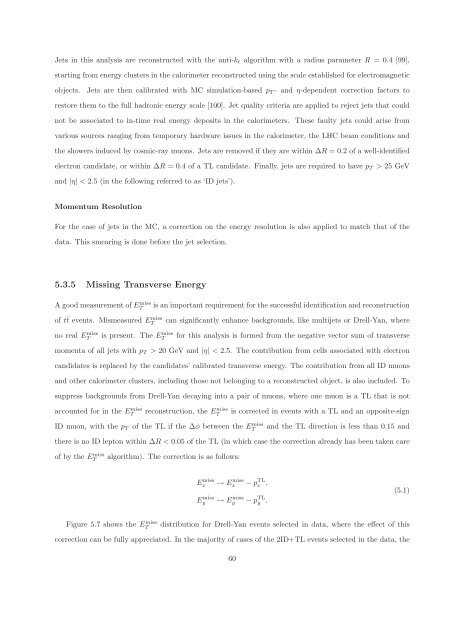CERN-THESIS-2012-153 26/07/2012 - CERN Document Server
CERN-THESIS-2012-153 26/07/2012 - CERN Document Server
CERN-THESIS-2012-153 26/07/2012 - CERN Document Server
You also want an ePaper? Increase the reach of your titles
YUMPU automatically turns print PDFs into web optimized ePapers that Google loves.
Jets in this analysis are reconstructed with the anti-kt algorithm with a radius parameter R = 0.4 [99],<br />
starting from energy clusters in the calorimeter reconstructed using the scale established for electromagnetic<br />
objects. Jets are then calibrated with MC simulation-based pT- and η-dependent correction factors to<br />
restore them to the full hadronic energy scale [100]. Jet quality criteria are applied to reject jets that could<br />
not be associated to in-time real energy deposits in the calorimeters. These faulty jets could arise from<br />
various sources ranging from temporary hardware issues in the calorimeter, the LHC beam conditions and<br />
the showers induced by cosmic-ray muons. Jets are removed if they are within ∆R = 0.2 of a well-identified<br />
electron candidate, or within ∆R = 0.4 of a TL candidate. Finally, jets are required to have pT > 25 GeV<br />
and |η| < 2.5 (in the following referred to as ‘ID jets’).<br />
Momentum Resolution<br />
For the case of jets in the MC, a correction on the energy resolution is also applied to match that of the<br />
data. This smearing is done before the jet selection.<br />
5.3.5 Missing Transverse Energy<br />
A good measurement of E miss<br />
T is an important requirement for the successful identification and reconstruction<br />
of t¯t events. Mismeasured E miss<br />
T<br />
no real E miss<br />
T<br />
is present. The E miss<br />
T<br />
can significantly enhance backgrounds, like multijets or Drell-Yan, where<br />
for this analysis is formed from the negative vector sum of transverse<br />
momenta of all jets with pT > 20 GeV and |η| < 2.5. The contribution from cells associated with electron<br />
candidates is replaced by the candidates’ calibrated transverse energy. The contribution from all ID muons<br />
and other calorimeter clusters, including those not belonging to a reconstructed object, is also included. To<br />
suppress backgrounds from Drell-Yan decaying into a pair of muons, where one muon is a TL that is not<br />
accounted for in the E miss<br />
T<br />
reconstruction, the E miss<br />
T<br />
ID muon, with the pT of the TL if the ∆φ between the E miss<br />
T<br />
is corrected in events with a TL and an opposite-sign<br />
and the TL direction is less than 0.15 and<br />
there is no ID lepton within ∆R < 0.05 of the TL (in which case the correction already has been taken care<br />
of by the E miss<br />
T<br />
algorithm). The correction is as follows:<br />
Figure 5.7 shows the E miss<br />
T<br />
E miss<br />
x<br />
E miss<br />
y<br />
→ E miss<br />
x − p TL<br />
x ,<br />
→ E miss<br />
y<br />
− p TL<br />
y .<br />
(5.1)<br />
distribution for Drell-Yan events selected in data, where the effect of this<br />
correction can be fully appreciated. In the majority of cases of the 2ID+TL events selected in the data, the<br />
60















